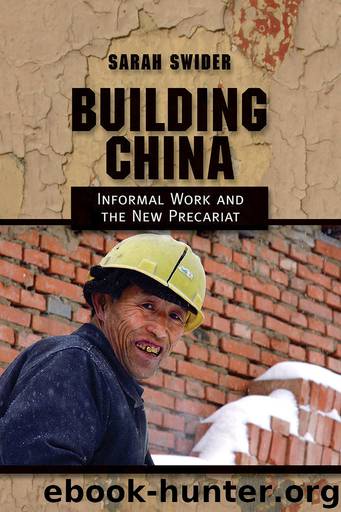Building China: Informal Work and the New Precariat by Sarah Swider

Author:Sarah Swider [Swider, Sarah]
Language: eng
Format: azw3
Publisher: Cornell University Press
Published: 2015-10-26T16:00:00+00:00
Fig. 5.2. A worker hauls bricks for this one-day job. Photo by Marcin Szczepanksi.
Jirong’s story highlights the ways in which bosses take advantage of migrants’ vulnerability. They know that migrants from the street labor market have no money, access to social welfare, or stable place to live. However, working for food and shelter is sometimes better than the alternatives, as Yun explains:
In Baoding, Xushu city, I worked in a brickyard. We worked three months and they still hadn’t paid us a cent. He [the boss] said that a sale didn’t come through so he couldn’t pay us. There isn’t any pay until there is a sale. He paid for the cost of food, made sure we ate, but there wasn’t any money, especially for serious things. Like if you got hurt, the most he would give you is 100 kuai [US$16], but we kept working. (personal interview, March 3, 2005)
When I asked him why he stayed, he responded:
He fed us, and he gave us a place to stay. I knew that once I left, it would be difficult. Where would I stay? What would I eat? When would I find the next job? Sometimes I just need a break from these problems. (personal interview, March 30, 2005)
Yun points out that even when workers do not receive the wages they earn, food relieves their hunger, and shelter takes them out of public spaces where they are constantly in danger of harassment, deportation, or death (from exposure). These inducements to keep working sustain a form of unfree labor. These migrants are not wage workers because often they are not paid for their work. Thus, workers frequently describe these employment arrangements as “slave-like.” For example, Yonghua said:
I worked for this boss for a long time like a slave. He had not paid me since I started. I honestly couldn’t contain myself and I couldn’t endure it any more. At that point, I was owed three thousand yuan [US$375] he only gave me five hundred yuan [US$62 dollars]. He did this because he thinks that we workers cannot fight back. It was so frustrating. (personal interview, April 1, 2005)
Workers compare individualized employment to slavery in reference to both the form of work and the lack of compensation. They are beaten and harassed, forcing them to work long hours at a fast pace. Also, their wages are often withheld, and they have no recourse. In this case, Yonghua had worked in his job for over a year and a half and was forced to walk away with one-sixth of the amount he was owed. Taken together, Jirong’s, Yun’s, and Jung’s stories point to the ways in which their labor is more unfree than free.
Another important characteristic of individualized employment is that the work is compensated at a piece rate and only paid when the job is done. This payment system is problematic for two reasons. First, the piece rate is so low that workers have to work extremely fast and long hours to earn enough for basic survival.
Download
This site does not store any files on its server. We only index and link to content provided by other sites. Please contact the content providers to delete copyright contents if any and email us, we'll remove relevant links or contents immediately.
| Anthropology | Archaeology |
| Philosophy | Politics & Government |
| Social Sciences | Sociology |
| Women's Studies |
The Secret History by Donna Tartt(18797)
The Social Justice Warrior Handbook by Lisa De Pasquale(12114)
Thirteen Reasons Why by Jay Asher(8761)
This Is How You Lose Her by Junot Diaz(6738)
Weapons of Math Destruction by Cathy O'Neil(6109)
Zero to One by Peter Thiel(5655)
Beartown by Fredrik Backman(5570)
The Myth of the Strong Leader by Archie Brown(5393)
The Fire Next Time by James Baldwin(5219)
How Democracies Die by Steven Levitsky & Daniel Ziblatt(5106)
Promise Me, Dad by Joe Biden(5063)
Stone's Rules by Roger Stone(5004)
A Higher Loyalty: Truth, Lies, and Leadership by James Comey(4818)
100 Deadly Skills by Clint Emerson(4817)
Rise and Kill First by Ronen Bergman(4673)
Secrecy World by Jake Bernstein(4612)
The David Icke Guide to the Global Conspiracy (and how to end it) by David Icke(4591)
The Farm by Tom Rob Smith(4413)
The Doomsday Machine by Daniel Ellsberg(4389)
